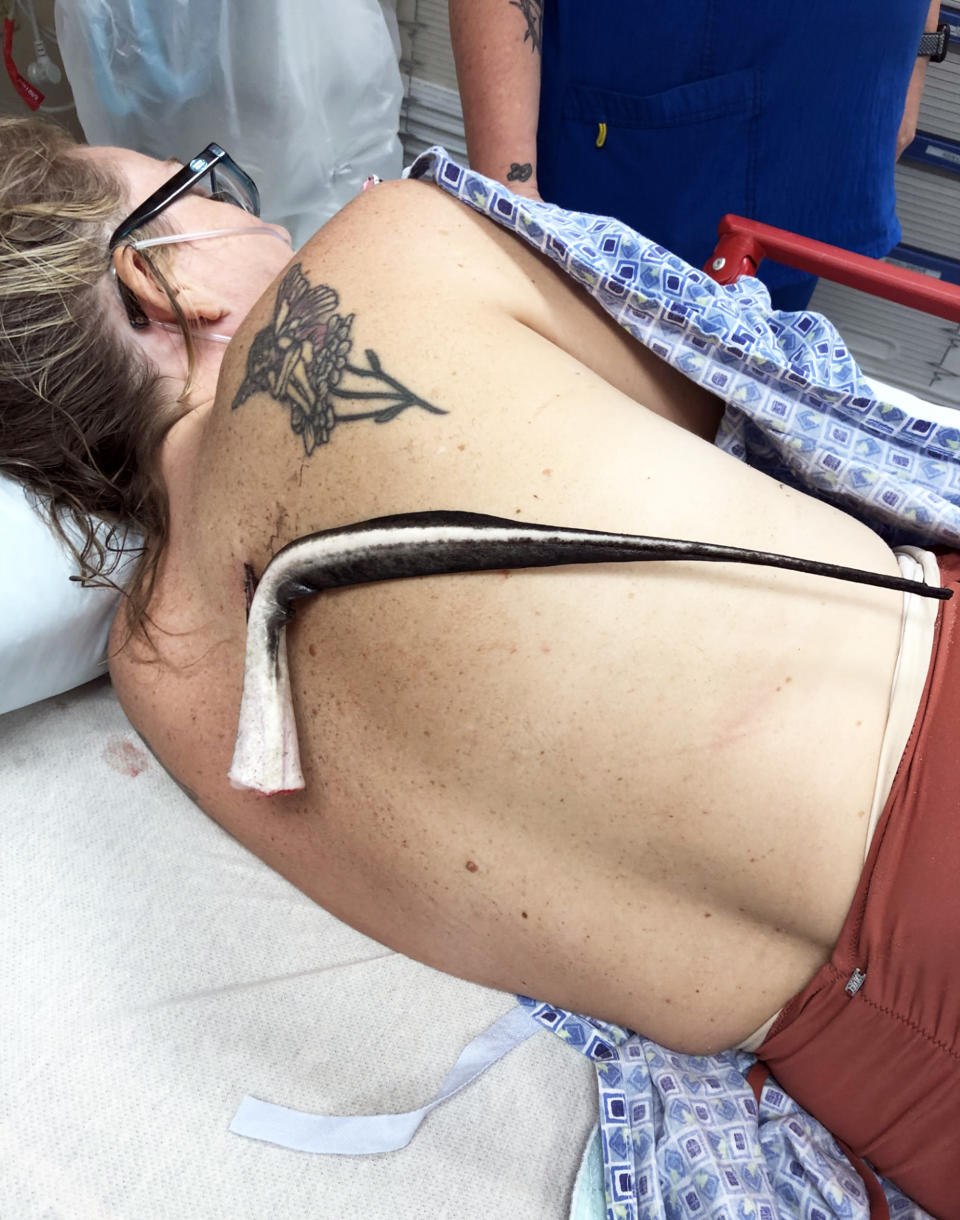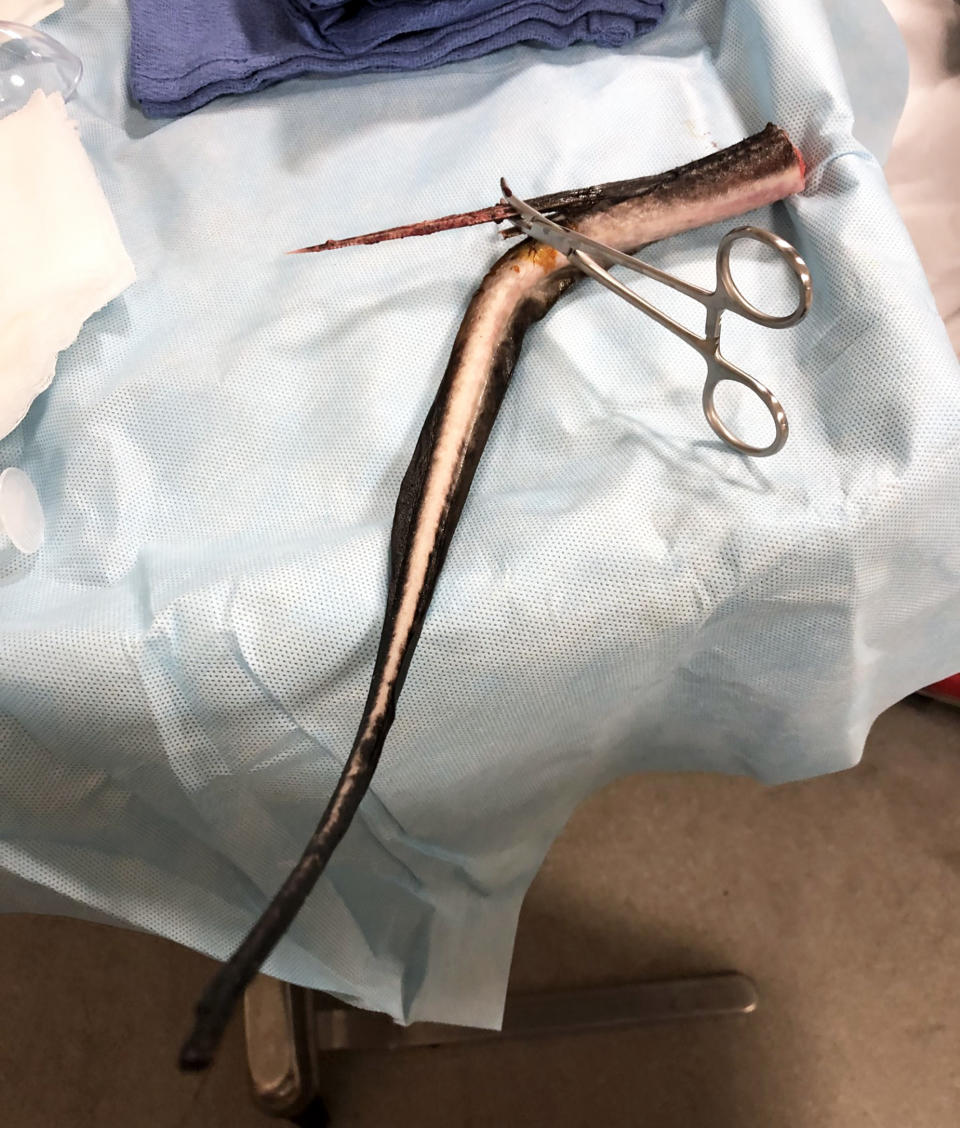Woman details being impaled by 4-foot stingray in shallow water: 'Super sharp'

A Florida woman is recovering after a stingray impaled her back and came within an inch of her lung with one of its barbs.
Kristie Cataffo-O’Brien had to undergo surgery to remove the stinger, spent a week in the hospital and still finds it incredibly painful to move her right arm.

The nurse says she had just waded into shallow water in Tampa Bay in Ruskin, Florida, on Aug. 22, sat on her knees and tilted her head back to get her hair wet when she immediately felt something sting her and experienced intense pain.
“It was super sharp,” Cataffo-O’Brien, 38, who lives in Apollo Beach, Florida, tells TODAY.com. “I thought that I had gotten stung by jelly fish. … When I stood up, that’s when (my husband) saw that the stingray was on me. It was on my back.”
Stingrays have 'complex' venom
Stingrays are shy and gentle, but they have long, thin tails equipped with up to three barbed, venomous spinal blades, which they use in self-defense when they feel threatened — often when they’re unintentionally stepped on, according to the National Capital Poison Center.
Besides puncturing flesh, the stinger also releases a "complex venom," which causes intense pain, the center adds. Complications include infection and serious bleeding.

Steve Irwin, the TV personality known as the “Crocodile Hunter,” died in 2006 when a stingray he was swimming with pierced his heart with its poisonous spine.
Death from a stingray barb is extremely rare, but it can happen if the puncture wound is in the chest, stomach or neck, the National Capital Poison Center notes.
Upper back pierced with two barbs
Cataffo-O’Brien doesn’t think she stepped on the creature, but she believes it was resting behind her and got startled. In Florida, beach goers who go in the water are advised to do the “stingray shuffle” — or slide their feet along the bottom — so that stingrays, which often bury themselves in the sand, will feel the vibrations and move away.
Cataffo-O’Brien, who has lived in Florida since she was 4, says she’s never encountered a stingray before and typically only did the shuffle in gulf waters, not the bay.
The stingray that pierced her back was about 4 feet across, and still alive and attached to her until first responders arrived and cut it off. She says she got through the ordeal by going into “a meditative state.”

“I do yoga and I meditate pretty much every day and you just take your mind to a safe spot,” Cataffo-O’Brien says. “My husband luckily just kept me super, super still and was talking to me and kept me calm the whole time.”
The stingray pierced the muscle of her upper back with two barbs, her husband, Thomas O’Brien, wrote on a GoFundMe page where he is raising money to help with medical bills.
Since the barbs were so close to Cataffo-O’Brien’s spine, a CT scan was done at the first hospital she was taken to. It showed one of the barbs was 3 centimeters, or about 1 inch, from her right lung. She was then transferred to trauma hospital, where surgeons removed the barbs while she was under general anesthesia.
If the barb had actually punctured her lung, Cataffo-O’Brien would likely still be in the hospital, she says, adding her lung may have collapsed and she wouldn't have been able to breathe.
Long recovery
Cataffo-O’Brien spent a week in the hospital and received intravenous antibiotics during her stay. She’s now at home but still struggles with pain in her right arm, which could be caused by the venom or the impact of the barb tearing through muscles, tissue and nerve endings.
She’ll receive occupational and physical therapy to try to gain some mobility back into her arm, but the ordeal has taken a toll.
“Physically and mentally, it’s been a lot. I’m a nurse, so I’m used to caring for other people, so it’s incredibly difficult for me to let people care for me and to ask for help,” Cataffo-O’Brien says.
“(My husband) is pretty shaken up still. He’s a deputy, so he’s used to being the first responder and the first one on the scene to things. But it’s been difficult for him to see me struggle and in pain.”
Still, she’s not scared of returning to the beach once her wounds heal: “I’ve lived in Florida for 35 years now, and I’ll continue to go back into the water,” she adds.
This article was originally published on TODAY.com

